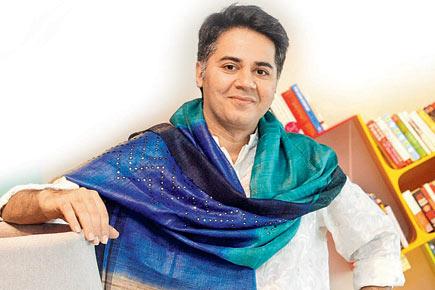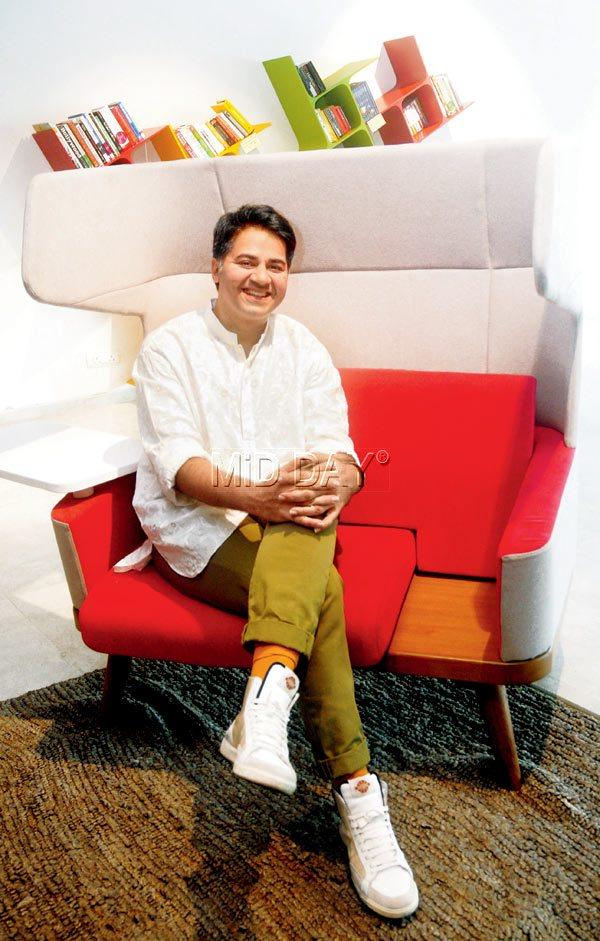The maverick, who managed to turn Vikhroli into a cultural hub within just three years, tells Rinky Kumar why he derives great joy from connecting dots...

Parmesh Shahani
Parmesh Shahani, Head, Godrej India Culture Lab
As I meet Parmesh Shahani one afternoon at the Godrej India Culture Lab in Vikhroli, the first thing that strikes me is his million-dollar smile. It exudes warmth that encourages people from different departments to greet him and during our 90-minute interview, he meets everyone with equal fervour. This, I soon realise, is one of his biggest qualities that makes it easier for him to connect with people across spheres with ease and helps him head Godrej India Culture Lab, an experimental space that cross-pollinates ideas and people.

Parmesh Shahani at the Godrej India Culture Lab. Pics/ Sameer Markande
As we settle down, he says, “I see myself as someone who creates new cultural spaces and sees links between different things. I get great joy in connecting the dots. People divide the performance from the visual, but for me, the joy lies in bridging the different boundaries.”
This passion stems from his exposure to performing arts at a very young age. Born in Colaba to middle-class parents, Shahani was fond of reading books, visiting art galleries and watching plays. “My grandfather often took me to Jehangir Art Gallery when I was seven. For me, going to the art gallery was as normal as going to a park to play,” smiles the student of St Joseph High School and Sydenham College.

Shahani landed his first job during the third year of college. How he landed it is an interesting story. He narrates, “When I was in college, I wanted to change the world. So one fine day, I met veteran journalists Bachi Karkaria and Shashi Baliga, who worked in a newspaper called Metropolis on Saturday and told them, ‘You are doing so many things wrong.’ They laughed and said, ‘Why don’t you help us make it better?”’ And that’s how I landed the job to edit the newspaper’s youth page. That incident taught me an important lesson that if you are complaining about something, then be a part of the solution.”
Enriched by the experience, the scribe decided to launch an online youth magazine called Fresh Lime Soda that invited youngsters to contribute articles on various subjects. “It was a platform for the youth to express themselves. So Nikhil Pahwa, who is now the editor of Medianama, wrote poems. Raghu Karnad, now a journalist, submitted articles and poems,” says the editor, who presently pens a column for a lifestyle magazine.
Spreading wings
After working for a couple of years, Shahani realised he needed to take time off to study and headed to the Massachusetts Institute of Technology (MIT) for a Masters of Science in Comparative Media Studies between 2003 and 2005. “It helped me contextualise my background and build a road map for the kind of things I wanted to do in my career. The MIT programme, which looked at media across geographies and boundaries, resonated with my ideology.”
He recalls the course also taught him significant lessons of life. “I learnt to value knowledge and humility. I saw Nobel Peace Prize winners waiting in queues in the canteen and having no qualms about it. One would see Amartya Sen sitting in the garden and you could go and talk to him. I realised that knowledge can be useful only if it is shared. So, I stayed back to set up a think tank related to media convergence with my MIT professor,” he explains.
After returning to India in 2006, Shahani started working on new media, venture capital and innovation for Mahindra & Mahindra. Two years later, he shot into limelight with his first book Gay Bombay: Globalisation, Love and (Be)Longing in Contemporary India, which was well received. In the book, he examined how Internet technologies, the media industry, audiences and broader socio-historical contexts shape gay identity in contemporary urban India. Around the same time, his friends back in the US prodded him to return and pursue a PhD in Communication at the Annenberg School for Communication at UPenn (University of Pennsylvania). In the same year, he got selected as a TED fellow and finally found his calling when he returned to India for the TED conference. “I realised that I didn’t want to do the PhD but in fact, create a space that connects people,” he elaborates.
Realising his dream
Shahani started meeting different people to bounce off his idea but finally got an approval from Nisa Godrej. The first event in 2011, titled Urban (Re) Imagination, was a conference where experts looked at urbanisation through history, geography and community. It received a good response and set the ball rolling. Over the last three years, the Godrej India Culture Lab has organised numerous events, including hosting iconic Japanese designer Kenya Hara, book reading sessions with authors, talks with fashion designers and film critics.
Quiz Shahani about his favourite events and he says, “The Museum of Memories (2012) and Vikhroli Skin (2013) are my favourites. Both the events saw hundreds of collaborators create magic.” While the former was a pop-up museum wherein artistes came together to create a depiction of the city’s iconic moments and kaleidoscopic past, the latter combined art, fashion, technology in a 200,000 sq feet warehouse.
Shahani says that heading the Godrej India Culture Lab has been replete with learnings and challenges. He elaborates, “The biggest challenge was that I realised people find it difficult to understand ideas that are way ahead of their times. You need a proof of concept to execute them. I also learnt that life is all about collaboration and if you approach people with honesty and integrity, things will work out. Our team comprises four youngsters but they collaborate with people from across the world whether it’s Stanford, Harvard, MIT and also across the city to organise events. The magic comes from the fact that we believe in the ideology ‘let’s share and add value to the world together.’ We follow three rules: The events are free, they are uploaded on our website to serve as a resource of knowledge and every event is followed by great food,” he smiles.
The curator, who now lives in Vikhroli, has developed a love for the central suburb. “I spent a major part of my life in South Mumbai. But for me now, SoBo is ‘So boring’ and Bandra is ‘Bourgeois Bandra’. All the action lies here. Viva Vikhroli,” he exclaims.
Global citizen
Earlier this year, Shahani was one of the 14 Indians to have made it to the list of Young Global Leaders recognised by the World Economic Forum and was also named as a 2014 Yale World fellow. He says these two honours have played a pivotal role in transforming his life. “Going to Yale was the biggest gift of my life. I learnt that leadership comes from listening and understanding complex problems but involves coming up with simple solutions. You need to have the courage to be yourself,” explains the venture capitalist.
As for the future, he maintains that Godrej India Culture Lab will be a catalyst for change. “We are ready to transform ideas into what the country needs. We owe it to our country to unite, create spaces and find solutions together to problems of environment and sanitation. But how will we go about it is something that I’m still figuring out,” he admits.
When Shahani is not traversing the world, he loves to settle down with a good book. The avid reader, who enjoys Indian writing in English, says, “Vikram Seth, Kiran Nagarkar and Salman Rushdie are my favourite authors. I also enjoy reading translated works. I loved reading the translation of Sachin Kundalkar’s work Cobalt Blue.”
Shahani is also known for his fetish for bow ties. But when I meet him, he is dressed in a white self-designed kurta, capris, sports shoes and a colourful shawl thrown around his shoulders. “I have always loved bow ties. I source them from a designer who makes them especially for me,” says the fashionista who adores the works of designers Sneha Arora, Ragini Ahuja, Kallol Dutta and Nimish Shah.
It’s easy to presume that the journalist, who is an avid collector of contemporary Indian art, may have some unfulfilled dreams but he smiles, “I live each day of my life as a dream. People cringe when they get up in the morning and think of going to work, but I’m excited as for me it’s not work but play.” Touché!
 Subscribe today by clicking the link and stay updated with the latest news!" Click here!
Subscribe today by clicking the link and stay updated with the latest news!" Click here!









